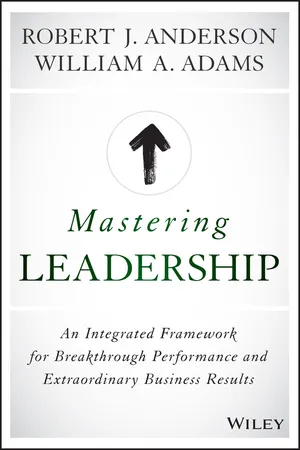
Mastering Leadership
An Integrated Framework for Breakthrough Performance and Extraordinary Business Results
- English
- ePUB (mobile friendly)
- Available on iOS & Android
Mastering Leadership
An Integrated Framework for Breakthrough Performance and Extraordinary Business Results
About this book
Is your leadership a competitive advantage, or is it costing you? How do you know? Are you developing your leadership effectiveness at the pace of change?
For most leaders today, complexity is outpacing their personal and collective development. Most leaders are in over their heads, whether they know it or not. The most successful organizations over time are the best led. While this has always been true, today escalating global complexity puts leadership effectiveness at a premium. Mastering Leadership involves developing the effectiveness of leaders—individually and collectively—and turning that leadership into a competitive advantage. This comprehensive roadmap for optimal leadership features:
- Breakthrough research that connects increased leadership effectiveness with enhanced business performance
- The first fully integrated Universal Model of Leadership—one that integrates the best theory and research in the fields of Leadership and Organizational Development over the last half century
- A free, online self-assessment of your leadership, using the Leadership Circle Profile, visibly outlining how you are currently leading and how to develop even greater effectiveness
- The five stages in the evolution of leadership—Egocentric, Reactive, Creative, Integral, and Unitive—along with the organizational structures and cultures that develop at each of these stages
- Six leadership practices for evolving your leadership capability at a faster pace
- A map of your optimal path to greater leadership effectiveness
- Case stories that facilitate pragmatic application of this Leadership Development System to your particular situation
This timeless, authoritative text provides a systemic approach for developing your senior leaders and the leadership system of your organization. It does not recommend quick fixes, but argues that real development requires a strategic, long-term, and integrated approach in order to forge more effective leaders and enhanced business performance. Mastering Leadership offers a developmental pathway to bring forth the highest and best use of yourself, your life, and your leadership. By more meaningfully deploying all of who you are every day, individually and collectively, you will achieve a leadership legacy consistent with your highest aspirations.
Frequently asked questions
- Essential is ideal for learners and professionals who enjoy exploring a wide range of subjects. Access the Essential Library with 800,000+ trusted titles and best-sellers across business, personal growth, and the humanities. Includes unlimited reading time and Standard Read Aloud voice.
- Complete: Perfect for advanced learners and researchers needing full, unrestricted access. Unlock 1.4M+ books across hundreds of subjects, including academic and specialized titles. The Complete Plan also includes advanced features like Premium Read Aloud and Research Assistant.
Please note we cannot support devices running on iOS 13 and Android 7 or earlier. Learn more about using the app.
Information
Chapter 1
The Promise of Leadership: Meeting the High Bar of Expectations
- Explicit: Expressed expectations for certain outcomes that come with the role and that show up in the leader's job description (things like fiscal responsibility, accountability, strategy, and execution).
- Implicit: Unspoken expectations that stakeholders have of their leaders (things like competence, fair treatment, commitment, engagement, listening, acting on suggestions, and providing inspiration, meaning, and direction). Leaders rarely understand the impact these implicit expectations have on their perceived effectiveness.
HIGH BAR OF EXPERIENCE AND EXPECTATIONS
LEADERSHIP MATTERS
FOUR UNIVERSAL PROMISES OF LEADERSHIP

Promise 1: Set the right direction and create meaningful work
Promise 2: Engage all stakeholders and hold them accountable
Table of contents
- Cover
- Praise
- Title page
- Copyright
- Acknowledgements
- Introduction A Universal Model of Leadership and the Leadership Circle Profile Assessment
- Chapter 1 The Promise of Leadership: Meeting the High Bar of Expectations
- Chapter 2 Leadership Effectiveness and Business Performance: The Primary Competitive Advantage
- Chapter 3 Mastery and Maturity, Consciousness and Complexity: The Leadership Development Agenda
- Chapter 4 Stages of Development: The Backbone of the Universal Model of Leadership
- Chapter 5 Five Levels of Leadership: Structures of Mind and Performance
- Chapter 6 The Universal Model and Metrics: Global Leadership, Cross-Cultural, and Gender Application
- Chapter 7 The Leadership System: The Central Organizing System
- Chapter 8 Reactive Leadership: An Insufficient Triumph of Development
- Chapter 9 Reactive Leadership at Work: From Patriarchy to Partnership
- Chapter 10 Creative Leadership: Fulfilling the Promise of Leadership
- Chapter 11 Six Leadership Practices: Spiritual Boot Camp for Leaders
- Chapter 12 Integral Leadership: Built for Complexity, Designed for Transformation
- Chapter 13 Unity: Journey's End, Development Turned Upside Down
- Appendix 1 Leadership Circle Profile Dimensions
- Appendix 2 Theorists Integrated into The Leadership Circle Universal Model of Leadership
- References
- About the Authors
- Index
- EULA